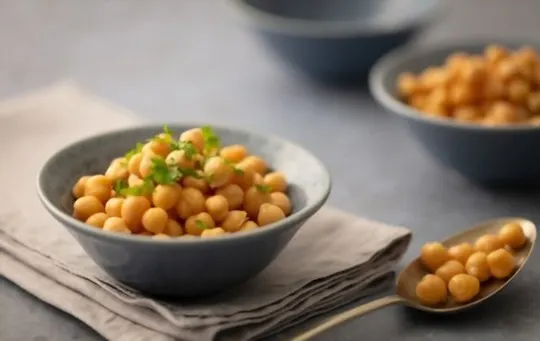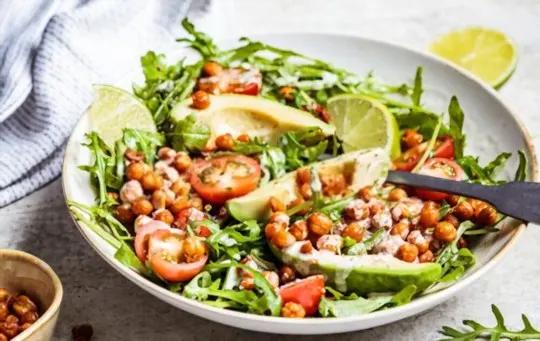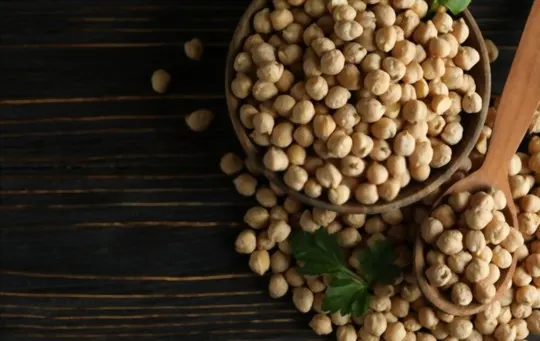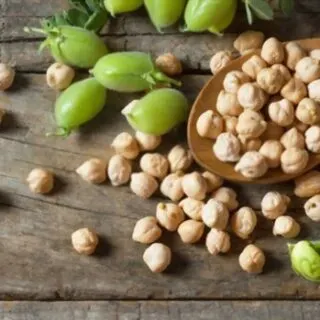Have you ever bit into a chickpea and had no clue what it tasted like? You’re not alone!
Chickpeas have an elusive taste, one that is sometimes debated about.
Some say they are nutty or earthy, some might argue for a more savory flavor, while others notice hints of sweetness in them.
But what do chickpeas really taste like?
In this comprehensive guide, we will explore all of the potential flavors that could be experienced when eating these divisive legumes.
By looking at various cooking techniques and accompanying ingredients to our ultimate tasting experience, you’ll have all the answers next time someone asks “What do chickpeas taste like?”
What are Chickpeas?

Chickpeas or Garbanzo beans, also known as the Egyptian pea or Bengal gram, are a type of legume originating in the Middle East and Mediterranean regions.
They have a nutty and creamy flavor with a grainy texture.
Chickpeas are commonly used in a variety of dishes such as hummus, falafel, stews, and salads due to their mild flavor and versatility.
When cooked, chickpeas have a tender texture and a subtle, earthy flavor.
They’re also popularly used in vegetarian and vegan diets due to their high protein and fiber content.
One can enjoy chickpeas in many ways, be it as part of a dish or as a standalone snack, making it a perfect addition to any diet.
To enhance the flavor of chickpeas, roast them with your favorite spices and herbs.
What Do Chickpeas Taste Like?

Chickpeas, also known as garbanzo beans, have a nutty and earthy taste with a buttery texture.
When cooked, they have a tender yet firm bite with a creamy interior.
The taste profile of chickpeas may vary depending on the dishes they are used in since they are commonly used in various cuisines worldwide.
Their versatility makes them an excellent ingredient in soups, stews, salads, spreads, and Indian curries.
They also pair well with different spices and herbs, creating a perfect balance of flavor.
Although chickpeas come canned, it is better to cook them from scratch to enjoy their full taste potential.
If you want to explore the many flavors of chickpeas, try experimenting with different recipes and cooking methods.
Pro tip: Roasting chickpeas with spices like cumin and paprika adds another level of flavor to their naturally nutty and earthy taste.
Flavor Factors that Affect the Taste of Chickpeas

Chickpeas have a nutty, mild, and earthy flavor with a firm texture that makes it a popular ingredient in many dishes.
However, its taste can be influenced by several factors.
- Soil: The condition of the soil in which the chickpeas are grown can affect their flavor profile. Ideal soil conditions promote optimal nutrient uptake and flavor development.
- Climate: The temperature and humidity levels in which the chickpeas are grown can affect their taste. Extreme temperatures and humidity levels can cause the chickpeas to taste off.
- Roasting: Roasting chickpeas can enhance their nutty and earthy flavor profile while also improving their crunchiness.
- Spices and Seasonings: Adding spices and seasonings such as cumin, paprika, and garlic powder can enhance the taste of chickpeas and provide additional layers of flavor.
To enhance the flavor of chickpeas, soak them in salted water for several hours before cooking to improve their taste and texture.
1 – Soil and Climate
Chickpeas have a mild, nutty flavor and a buttery yet firm texture.
When cooked, chickpeas have a soft, creamy interior and maintain their shape well.
Soil and climate play a key role in determining the taste and texture of chickpeas.
Chickpeas grow best in dry climates with well-drained soil that’s rich in organic matter.
Ideal temperatures for chickpea growth range from 18-20 degrees Celsius.
Higher temperatures can reduce growth rates and lower yields, while lower temperatures can cause frost damage and poor germination.
Chickpeas grown in colder climates tend to have a nuttier flavor and harder texture, while those grown in warmer climates may have a softer texture and creamier flavor.
2 – Roasting or Boiling
Roasting or boiling chickpeas can enhance their natural nutty and creamy flavor while changing their texture and increasing their versatility in recipes.
Roasting chickpeas gives them a crispy and crunchy texture with a nutty and smoky flavor.
Simply toss chickpeas with olive oil and spices of your choice and bake them at 375°F for 20-25 minutes or until golden brown.
Boiling chickpeas can make them softer and creamier, perfect for making hummus and other dips.
Simply soak the chickpeas in water overnight, then boil them in a pot of salted water for 1-1.
5 hours, or until they are tender.
Whether you roast or boil chickpeas, you can use them in a variety of dishes, from salads and soups to snacks and side dishes.
Chickpeas are an excellent source of plant-based protein and fiber, making them a valuable addition to a healthy diet.
Health Benefits of Chickpeas

Chickpeas are an excellent source of plant-based protein, fiber, and essential vitamins and minerals, all with a mild, nutty flavor and a firm, creamy texture.
Here are some health benefits of chickpeas:
- High in fiber, which promotes bowel regularity, reduces inflammation, and helps maintain a healthy gut microbiome.
- A good source of plant-based protein, which is beneficial for vegetarians and vegans looking to meet their daily protein requirements.
- Rich in essential vitamins and minerals, including iron, magnesium, and Vitamin B6, which help to support healthy blood sugar levels, maintain bone health and support heart health.
Chickpeas are mild, earthy, and nutty in flavor, with a firm, creamy texture when cooked.
They absorb the flavors of other ingredients, making them a great addition to salads, soups, and stews.
Give them a try in hummus, falafel, or roasted with spices for a flavorful plant-based snack.
How to Use Chickpeas in Cooking?

Chickpeas are a versatile and healthy ingredient that can add texture, flavor, and nutrition to your dishes.
The taste of chickpeas can be described as earthy, nutty, and slightly sweet.
Here are some ways you can use chickpeas in your cooking:
- Roast or toast them for a crispy snack.
- Add them to soups, stews, and curries for a protein boost.
- Use them to make hummus, falafel, or veggie burgers.
- Mash them up and use as a substitute for meat in tacos or Shepherd’s pie.
- Make a Mediterranean salad with chickpeas, tomatoes, cucumbers, and feta cheese.
Chickpeas are packed with protein, fiber, and other essential nutrients, making them an excellent addition to any diet.
Conclusion
In conclusion, chickpeas taste nutty and buttery with a slightly grainy texture.
Their mild flavor complements a wide range of sweet and savory dishes, making them versatile ingredients in any kitchen.
Chickpeas are also a good source of protein and fiber, making them a healthy addition to your diet.
They can be consumed raw or cooked, and their taste can be enhanced with different seasonings such as garlic, lemon, and cumin.
Chickpeas are an essential ingredient in many traditional Middle Eastern and Mediterranean dishes, such as hummus, falafel, and chana masala.
With their pleasant taste, nutritional benefits, and culinary versatility, chickpeas are a must-try ingredient for any food lover looking to expand their horizons in the kitchen.

What Do Chickpeas Taste Like? A Comprehensive Guide
Ingredients
- Chickpeas
- Ingredients from your selected recipes
Instructions
- Select your favorite ingredient from the range available in this article.
- Collect all the necessary items to make the recipe.
- Use the instructions provided to prepare a delicious dish in 30 minutes or less.

Carrie is a food writer and editor with more than 15 years of experience. She has worked for some of the biggest names in the food industry, including Bon Appétit, Food & Wine, and Martha Stewart Living.
As the Editor in Chief of IntroChicago.com, Carrie oversees all of the content on the site. She also manages the team of contributing writers and editors, who help to create delicious recipes, helpful tips, and informative articles that you’ll find on the site.
A native of the Chicago area, Carrie is passionate about all things food. She loves trying new restaurants and experimenting with new recipes in her kitchen. She’s also a graduate of the Culinary Institute of America, so she knows a thing or two about food!
